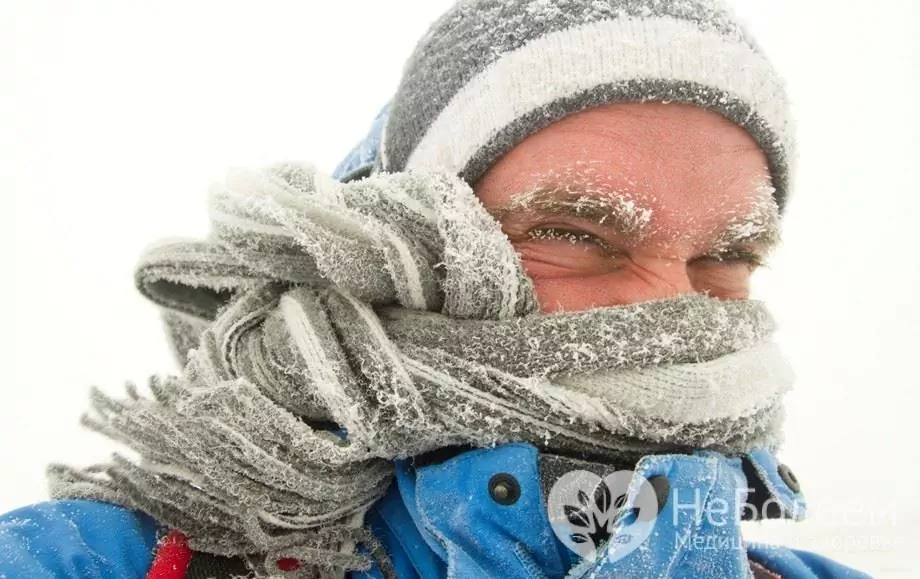- Author Rachel Wainwright [email protected].
- Public 2023-12-15 07:39.
- Last modified 2025-11-02 20:14.
First aid for frostbite
Frostbite (frostbite) is tissue damage that occurs at low temperatures (usually below -10 ° C). It can be observed even at zero ambient temperature - in cases where there are large heat losses per unit of time.

Source: depositphotos.com
First of all, protruding and insufficiently protected parts of the body are exposed to aggressive effects: ears, nose, cheeks, hands, feet. Subsequently, general hypothermia of the body develops with a decrease in body temperature to critical figures.
Risk factors that reduce the effectiveness of thermoregulation and contribute to the development of frostbite:
- increased heat transfer (harsh wind, high humidity, light clothing);
- local disturbance of microcirculation (tight shoes, prolonged immobility, forced body position);
- associated conditions that weaken the body's resistance to extreme influences (trauma, blood loss, physical or emotional exhaustion, stress);
- vascular diseases.
The greatest risk of frostbite, according to statistics, are persons in a state of alcoholic intoxication (severe or moderate severity). This is due to partial or complete disorientation, a slowdown in response to stimuli, and a specific vegetative background.
Degrees and signs of frostbite
Depending on the duration and intensity of the aggressive effect, as well as on the nature of tissue damage, 4 degrees of frostbite are distinguished.
The initial manifestations in all cases are similar (which does not allow to reliably determine the degree of frostbite in the first hours after injury):
- pallor and coldness of the skin;
- decreased sensitivity.
After the appearance of the first general symptoms, symptoms specific to each degree of frostbite develop:
- It is characterized by mild soreness of the skin, after warming, intense redness and slight swelling are noted, peeling of the affected areas is possible without the development of necrosis. After 5-7 days, the skin manifestations completely disappear.
- Blisters of different sizes, filled with transparent (serous) contents, appear on damaged skin areas within 24-48 hours. Painful sensations are intense, itching, burning of injured skin is characteristic. With proper treatment, the skin condition is restored after 7-14 days, there are no cicatricial deformities at the site of the lesion.
- Necrosis of the damaged skin occurs, which leads to loss of sensitivity and the formation, after warming, of massive painful blisters with a purple-cyanotic base, filled with bloody contents. Subsequently, the blisters are necrotic and rejected with the formation of scars and granulations. Scarring can last up to a month, and rejection of the nail plates, sometimes irreversible, also occurs.
- It is manifested by total necrosis of not only the skin, but also the underlying soft tissues (up to the bones and joints). The injured areas of the skin are cyanotic, after warming, a sharply increasing edema is formed, there are no bubbles, the sensitivity of the skin after warming is not restored, subsequently gangrene develops. The affected areas are subject to amputation.
With prolonged exposure to low temperatures, general hypothermia is possible, as evidenced by a decrease in body temperature to 34 ºС and below (up to 29-30 ºС in severe cases). Depending on the severity, the condition is manifested by inhibition of the respiratory, cardiovascular and nervous systems of varying intensity, up to coma and death.

First aid for frostbite
In case of damage of any intensity, first of all, it is necessary to deliver the victim to a warm room as soon as possible. If there is a possibility of repeated frostbite, the damaged part of the body must not be allowed to thaw; otherwise, cover it carefully. Further measures depend on the degree of frostbite.
With frostbite of I degree, it is required:
- warm the affected skin (breathing, rubbing gently with a soft woolen cloth or hands);
- apply a warming cotton-gauze bandage in several layers.
With frostbite II-IV degree you need:
- exclude rapid warming (massage, rubbing);
- apply a heat-insulating bandage (bandage and cotton wool in several layers, you can use scarves, woolen fabric, scarves);
- fix the frostbitten limb;
- call an ambulance team.
It is recommended to give the victim a hot drink and food, you can take Aspirin, Analgin with Papaverine or No-shpa to improve blood microcirculation.
What should not be done in case of frostbite?
Absolutely forbidden:
- rub the frostbitten surface with snow, a hard cloth (there is a high probability of injury and subsequent infection of damaged skin);
- expose the place of frostbite to intense heat (using a hot bath, heating pad, heater, etc.);
- rub the damaged skin with oil, fat, alcohol, as this can complicate the course of the disease;
- independently open bubbles and remove necrotic tissue.
When should you see a doctor?
At home, only degree I frostbite can be treated; in all other cases, it is necessary to seek specialized help.
In case of frostbite of the II degree, the opening of the bubbles and their processing are carried out in a surgical room. To prevent the addition of infection, an aseptic bandage is applied and appropriate therapy is prescribed.
With frostbite of III-IV degree in a hospital, necrotic tissues are removed, anti-inflammatory and antibacterial therapy is performed.

Source: ozdorovitel.com
Features of frostbite in children
In children, frostbite develops much faster than in adults, which is associated with the peculiarity of the structure of the skin and their blood supply.
The situation is aggravated by the inability of a child (especially a younger age) to critically assess his condition. Continuing to be outdoors can exacerbate the damage.
Redness of open areas of the face while walking is a normal reaction of skin vessels to environmental influences. An alarming sign is the sudden pallor of the skin: this may indicate developing frostbite.

YouTube video related to the article:
Found a mistake in the text? Select it and press Ctrl + Enter.






